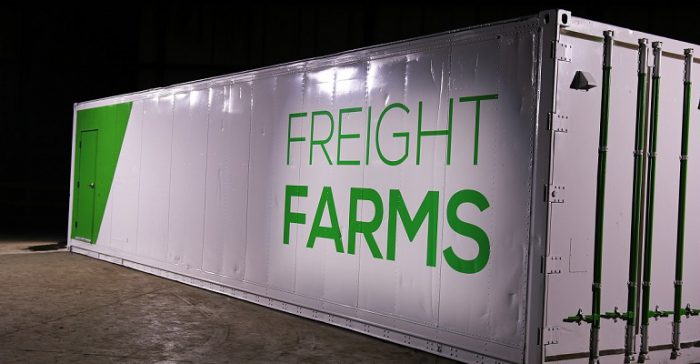Could The Future Of Urban Farming Be Found Inside Of An Old Shipping Container?
Think Progress, February 4, 2016. Image credit: Freight Farms
Freight Farms cofounder Brad McNamara first got the idea for creating farms in shipping containers while working in rooftop farm consulting throughout Boston as a graduate student. McNamara was trying to figure out ways to make rooftop hydroponic farming more efficient — but realized the potential for highly-efficient local farming spread well beyond Boston’s rooftops.
“One of the big issues we saw when we were looking at greenhouses and rooftop space was that every project is a unique custom piece of equipment and a very complex system,” McNamara told ThinkProgress. Despite a wealth of research describing the ideal conditions for growing crops in hydroponic systems — systems that use nutrient-rich water instead of soil — McNamara and his partner were having a hard time figuring out how to make those conditions replicable regardless of a farm’s location.
Maximizing the efficiency of a Freight Farms unit — and thereby reducing the amount of energy and water required to grow crops throughout the system — has been a priority for McNamara since the company began. Right now, McNamara said, a single unit uses around 10 gallons of water per day, and between 30,000 to 35,000 kilowatt hours of energy per year. While the water footprint is fairly small — the average American shower uses about two gallons of water a minute — the energy footprint is three times the electricity used annually by an average American home.
Freight Farms units are still at the mercy of the grid — a farmer typically can’t choose whether the energy needed to power the unit comes from a low-carbon option like wind or solar, or from a carbon-polluting option like coal. But McNamara has been working on making the units themselves more energy efficient — between 2014 and 2015, Freight Farms worked to increase the system’s efficiency by 30 percent. They didn’t quite get there, topping out at a 26 percent increase in efficiency, but McNamara remains committed to the idea of streamlining the system as much as possible. That means including things like external monitors that can sense the outside temperature and use small, low-energy fans to pump cold or warm air into the container, which can lower or raise the temperature inside the container without using much energy.
